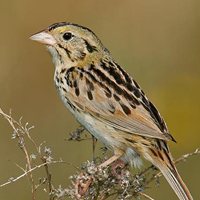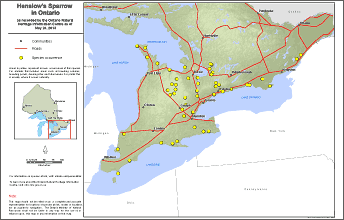Henslow’s sparrow
Scientific name: Ammodramus henslowii

Cover photo credit: Brian E. Small
Status
Endangered
“Endangered” means the species lives in the wild in Ontario but is facing imminent extinction or extirpation.
Date added to the Species at Risk in Ontario List
The Henslow’s Sparrow was already assessed as endangered when the Endangered Species Act took effect in 2008.
What it looks like
The Henslow’s Sparrow can be distinguished from other sparrows by its combination of chestnut brown wings, intricately patterned olive-green head and back of neck, black and brown streaked back, and by its flat-headed, short-tailed profile.
This small, secretive bird is hard to spot, and is most often located by its odd song – a dry, thin, metallic sound usually mistaken for an insect.
Where it lives
The Henslow’s Sparrow breeds in the northeastern and east-central United States, and reaches its northeastern limit in Ontario.
It has also been found in abandoned farm fields, pastures, and wet meadows.
It tends to avoid fields that have been grazed or are crowded with trees and shrubs. It prefers extensive, dense, tall grasslands where it can more easily conceal its small ground nest.
Where it’s been found in Ontario
In Ontario, the Henslow’s Sparrow lives in open fields with tall grasses, flowering plants, and a few scattered shrubs.
It was once fairly common in scattered areas of suitable habitat south of the Canadian Shield.
However, steep declines since the 1960s have all but wiped this bird out as a breeding species in Ontario.
A few are still seen each spring at migration hotspots such as Point Pelee National Park, and a few may breed at selected locations.
View a Larger version of this map (PDF)
What threatens it
The main threat to the Henslow’s Sparrow is loss of open field prairie habitat. Many of the sites where this bird once lived have been converted to pasture, crop lands, or tree plantations.
Housing development has also removed suitable habitat.
Action we are taking
Endangered Species and their general habitat are automatically protected
Recovery strategy
A recovery strategy advises the ministry on ways to ensure healthy numbers of the species return to Ontario.
Read the executive summary (March 2, 2015)
Read the recovery strategy (March 2, 2015)
Government response statement
A government response statement outlines the actions the government intends to take or support to help recover the species.
Read the government response statement (March 23, 2016)
Review of progress
A review of progress made toward protecting and recovering a species is required no later than the time specified in the species’ government response statement, or not later than five years after the government response statement is published if no time is specified.
Read the report on progress towards the protection and recovery of 18 species at risk, including Henslow’s Sparrow (2021).
Habitat protection
General habitat descriptions are technical, science-based documents that provide greater clarity on the area of habitat protected for a species.
Read the general habitat description (July 2, 2013)
What you can do
Report a sighting
- Report a sighting of an endangered animal or plant to the Natural Heritage Information Centre. Photographs with specific locations or mapping coordinates are always helpful.
- Bird Studies Canada is working to advance the understanding, appreciation and conservation of wild birds and their habitat in Ontario and elsewhere. For more information on how you can help, visit:
www.bsc-eoc.org.
Volunteer
- Volunteer with your local nature club or provincial park to participate in surveys or stewardship work focused on species at risk.
Be a good steward
- Private land owners have a very important role to play in species recovery. If you find a nesting on your land, you may be eligible for stewardship programs that support the protection and recovery of species at risk and their habitats.
- Henslow’s Sparrow and many other species at risk depend on healthy grassland prairies which is rare in Ontario. Learn more about these important habitats, the species that depend on them, and what you can do to help at:
www.tallgrassontario.org - The Canada-Ontario Farm Stewardship Program is available to eligible farmers to encourage greater protection and conservation of habitat for species at risk.
Report illegal activity
- Report any illegal activity related to plants and wildlife to
1-877-TIP-SMNR (847-7667) .
Quick facts
- The Henslow’s Sparrow is a short-distance migrant, travelling only as far as the southern United States, primarily from Texas to Georgia.
- Henslow’s Sparrows are very shy and are almost never seen when they’re not singing. If you hear one, look for it sitting on top of a mullein flower stalk or other elevated twig or perch. When it sings, it sharply throws its head skyward and then utters its quiet song. In early summer, it frequently sings throughout the night.
- Henslow’s Sparrows often build their nests in tallgrass prairies, which are one of the most endangered habitats in Ontario. This extremely rare habitat supports an amazing diversity of wildlife, including many species at risk.
